Strategic HR Decision Making: A Workforce Plan for Tesco's Growth
VerifiedAdded on 2023/06/18
|36
|5330
|341
Report
AI Summary
This report provides a comprehensive analysis of strategic decision-making in an HR context, focusing on Tesco as a case study. It explores the aim, scope, and purpose of strategic workforce planning, examines internal and external influences on HR functions, and evaluates strategic and operational considerations. The report connects contemporary theory with practical applications, demonstrating how HR strategies support business objectives, performance, and sustainable growth. It also includes an individual strategic workforce plan for Tesco's talent management director, evaluating change management models, HR's role in sustainable business performance, and methods for monitoring and evaluating HR strategy success. The report concludes with recommendations for applying specific techniques to monitor the potential impact of the workforce plan. Desklib provides access to similar solved assignments and past papers for students.
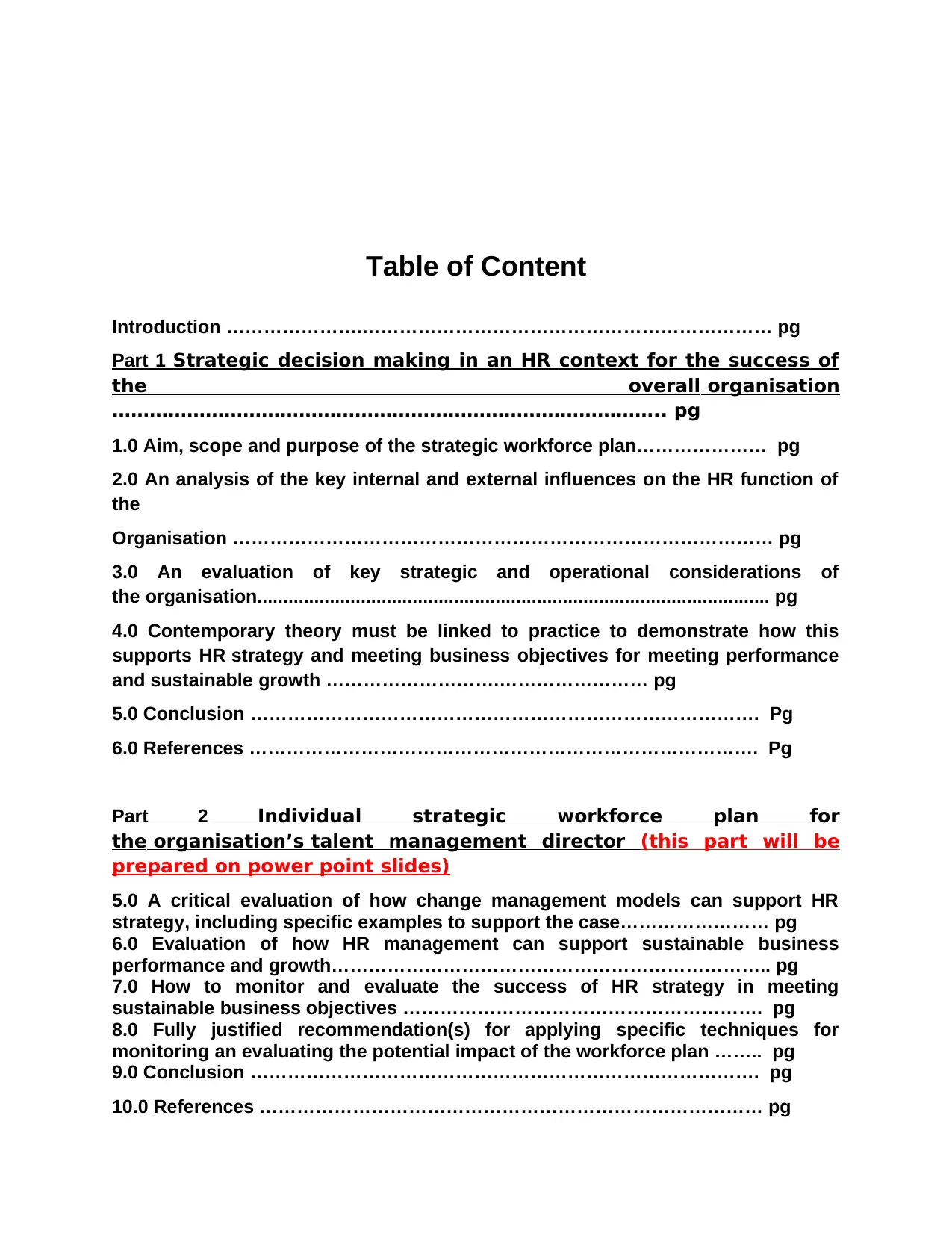
Table of Content
Introduction ………………….………………………………………………………… pg
Part 1 Strategic decision making in an HR context for the success of
the overall organisation
…………………………………………………………………………….. pg
1.0 Aim, scope and purpose of the strategic workforce plan………………… pg
2.0 An analysis of the key internal and external influences on the HR function of
the
Organisation …………………………………………………………………………… pg
3.0 An evaluation of key strategic and operational considerations of
the organisation................................................................................................... pg
4.0 Contemporary theory must be linked to practice to demonstrate how this
supports HR strategy and meeting business objectives for meeting performance
and sustainable growth ……………………….…………………… pg
5.0 Conclusion ………………………………………………………………………. Pg
6.0 References ………………………………………………………………………. Pg
Part 2 Individual strategic workforce plan for
the organisation’s talent management director (this part will be
prepared on power point slides)
5.0 A critical evaluation of how change management models can support HR
strategy, including specific examples to support the case…………………… pg
6.0 Evaluation of how HR management can support sustainable business
performance and growth…………………………………………………………….. pg
7.0 How to monitor and evaluate the success of HR strategy in meeting
sustainable business objectives …………………………………………………. pg
8.0 Fully justified recommendation(s) for applying specific techniques for
monitoring an evaluating the potential impact of the workforce plan …….. pg
9.0 Conclusion ………………………………………………………………………. pg
10.0 References ……………………………………………………………………… pg
Introduction ………………….………………………………………………………… pg
Part 1 Strategic decision making in an HR context for the success of
the overall organisation
…………………………………………………………………………….. pg
1.0 Aim, scope and purpose of the strategic workforce plan………………… pg
2.0 An analysis of the key internal and external influences on the HR function of
the
Organisation …………………………………………………………………………… pg
3.0 An evaluation of key strategic and operational considerations of
the organisation................................................................................................... pg
4.0 Contemporary theory must be linked to practice to demonstrate how this
supports HR strategy and meeting business objectives for meeting performance
and sustainable growth ……………………….…………………… pg
5.0 Conclusion ………………………………………………………………………. Pg
6.0 References ………………………………………………………………………. Pg
Part 2 Individual strategic workforce plan for
the organisation’s talent management director (this part will be
prepared on power point slides)
5.0 A critical evaluation of how change management models can support HR
strategy, including specific examples to support the case…………………… pg
6.0 Evaluation of how HR management can support sustainable business
performance and growth…………………………………………………………….. pg
7.0 How to monitor and evaluate the success of HR strategy in meeting
sustainable business objectives …………………………………………………. pg
8.0 Fully justified recommendation(s) for applying specific techniques for
monitoring an evaluating the potential impact of the workforce plan …….. pg
9.0 Conclusion ………………………………………………………………………. pg
10.0 References ……………………………………………………………………… pg
Paraphrase This Document
Need a fresh take? Get an instant paraphrase of this document with our AI Paraphraser
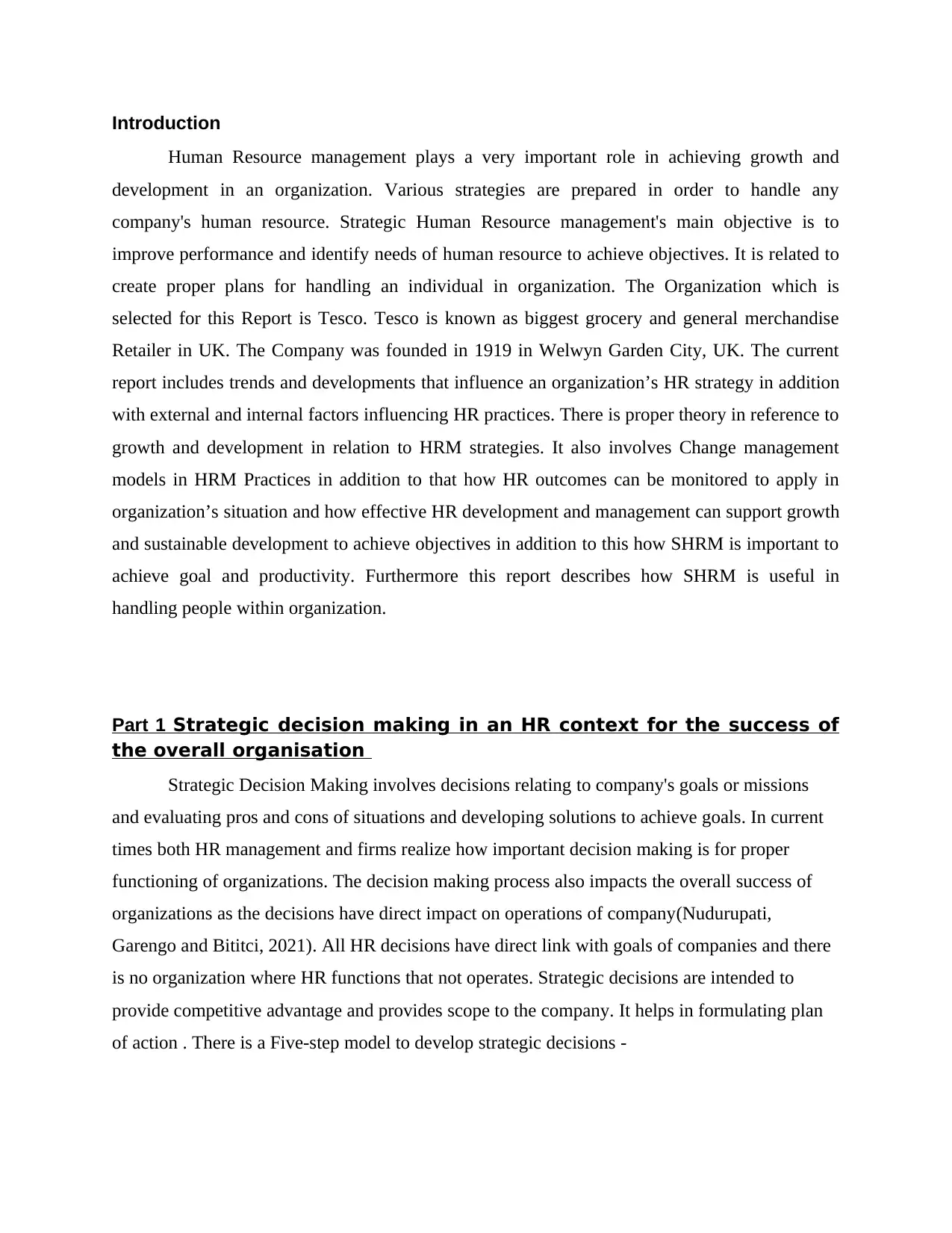
Introduction
Human Resource management plays a very important role in achieving growth and
development in an organization. Various strategies are prepared in order to handle any
company's human resource. Strategic Human Resource management's main objective is to
improve performance and identify needs of human resource to achieve objectives. It is related to
create proper plans for handling an individual in organization. The Organization which is
selected for this Report is Tesco. Tesco is known as biggest grocery and general merchandise
Retailer in UK. The Company was founded in 1919 in Welwyn Garden City, UK. The current
report includes trends and developments that influence an organization’s HR strategy in addition
with external and internal factors influencing HR practices. There is proper theory in reference to
growth and development in relation to HRM strategies. It also involves Change management
models in HRM Practices in addition to that how HR outcomes can be monitored to apply in
organization’s situation and how effective HR development and management can support growth
and sustainable development to achieve objectives in addition to this how SHRM is important to
achieve goal and productivity. Furthermore this report describes how SHRM is useful in
handling people within organization.
Part 1 Strategic decision making in an HR context for the success of
the overall organisation
Strategic Decision Making involves decisions relating to company's goals or missions
and evaluating pros and cons of situations and developing solutions to achieve goals. In current
times both HR management and firms realize how important decision making is for proper
functioning of organizations. The decision making process also impacts the overall success of
organizations as the decisions have direct impact on operations of company(Nudurupati,
Garengo and Bititci, 2021). All HR decisions have direct link with goals of companies and there
is no organization where HR functions that not operates. Strategic decisions are intended to
provide competitive advantage and provides scope to the company. It helps in formulating plan
of action . There is a Five-step model to develop strategic decisions -
Human Resource management plays a very important role in achieving growth and
development in an organization. Various strategies are prepared in order to handle any
company's human resource. Strategic Human Resource management's main objective is to
improve performance and identify needs of human resource to achieve objectives. It is related to
create proper plans for handling an individual in organization. The Organization which is
selected for this Report is Tesco. Tesco is known as biggest grocery and general merchandise
Retailer in UK. The Company was founded in 1919 in Welwyn Garden City, UK. The current
report includes trends and developments that influence an organization’s HR strategy in addition
with external and internal factors influencing HR practices. There is proper theory in reference to
growth and development in relation to HRM strategies. It also involves Change management
models in HRM Practices in addition to that how HR outcomes can be monitored to apply in
organization’s situation and how effective HR development and management can support growth
and sustainable development to achieve objectives in addition to this how SHRM is important to
achieve goal and productivity. Furthermore this report describes how SHRM is useful in
handling people within organization.
Part 1 Strategic decision making in an HR context for the success of
the overall organisation
Strategic Decision Making involves decisions relating to company's goals or missions
and evaluating pros and cons of situations and developing solutions to achieve goals. In current
times both HR management and firms realize how important decision making is for proper
functioning of organizations. The decision making process also impacts the overall success of
organizations as the decisions have direct impact on operations of company(Nudurupati,
Garengo and Bititci, 2021). All HR decisions have direct link with goals of companies and there
is no organization where HR functions that not operates. Strategic decisions are intended to
provide competitive advantage and provides scope to the company. It helps in formulating plan
of action . There is a Five-step model to develop strategic decisions -
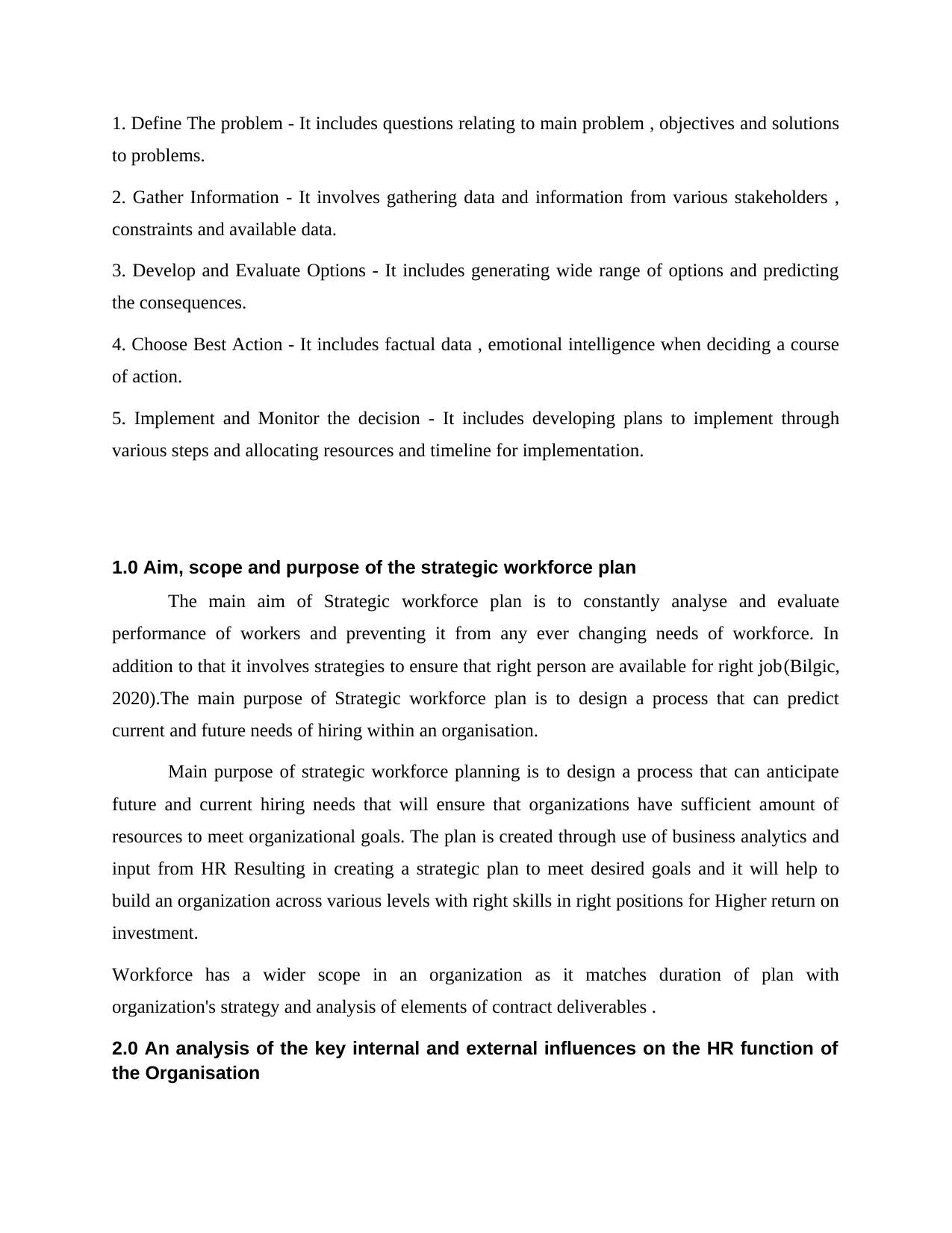
1. Define The problem - It includes questions relating to main problem , objectives and solutions
to problems.
2. Gather Information - It involves gathering data and information from various stakeholders ,
constraints and available data.
3. Develop and Evaluate Options - It includes generating wide range of options and predicting
the consequences.
4. Choose Best Action - It includes factual data , emotional intelligence when deciding a course
of action.
5. Implement and Monitor the decision - It includes developing plans to implement through
various steps and allocating resources and timeline for implementation.
1.0 Aim, scope and purpose of the strategic workforce plan
The main aim of Strategic workforce plan is to constantly analyse and evaluate
performance of workers and preventing it from any ever changing needs of workforce. In
addition to that it involves strategies to ensure that right person are available for right job(Bilgic,
2020).The main purpose of Strategic workforce plan is to design a process that can predict
current and future needs of hiring within an organisation.
Main purpose of strategic workforce planning is to design a process that can anticipate
future and current hiring needs that will ensure that organizations have sufficient amount of
resources to meet organizational goals. The plan is created through use of business analytics and
input from HR Resulting in creating a strategic plan to meet desired goals and it will help to
build an organization across various levels with right skills in right positions for Higher return on
investment.
Workforce has a wider scope in an organization as it matches duration of plan with
organization's strategy and analysis of elements of contract deliverables .
2.0 An analysis of the key internal and external influences on the HR function of
the Organisation
to problems.
2. Gather Information - It involves gathering data and information from various stakeholders ,
constraints and available data.
3. Develop and Evaluate Options - It includes generating wide range of options and predicting
the consequences.
4. Choose Best Action - It includes factual data , emotional intelligence when deciding a course
of action.
5. Implement and Monitor the decision - It includes developing plans to implement through
various steps and allocating resources and timeline for implementation.
1.0 Aim, scope and purpose of the strategic workforce plan
The main aim of Strategic workforce plan is to constantly analyse and evaluate
performance of workers and preventing it from any ever changing needs of workforce. In
addition to that it involves strategies to ensure that right person are available for right job(Bilgic,
2020).The main purpose of Strategic workforce plan is to design a process that can predict
current and future needs of hiring within an organisation.
Main purpose of strategic workforce planning is to design a process that can anticipate
future and current hiring needs that will ensure that organizations have sufficient amount of
resources to meet organizational goals. The plan is created through use of business analytics and
input from HR Resulting in creating a strategic plan to meet desired goals and it will help to
build an organization across various levels with right skills in right positions for Higher return on
investment.
Workforce has a wider scope in an organization as it matches duration of plan with
organization's strategy and analysis of elements of contract deliverables .
2.0 An analysis of the key internal and external influences on the HR function of
the Organisation
⊘ This is a preview!⊘
Do you want full access?
Subscribe today to unlock all pages.

Trusted by 1+ million students worldwide
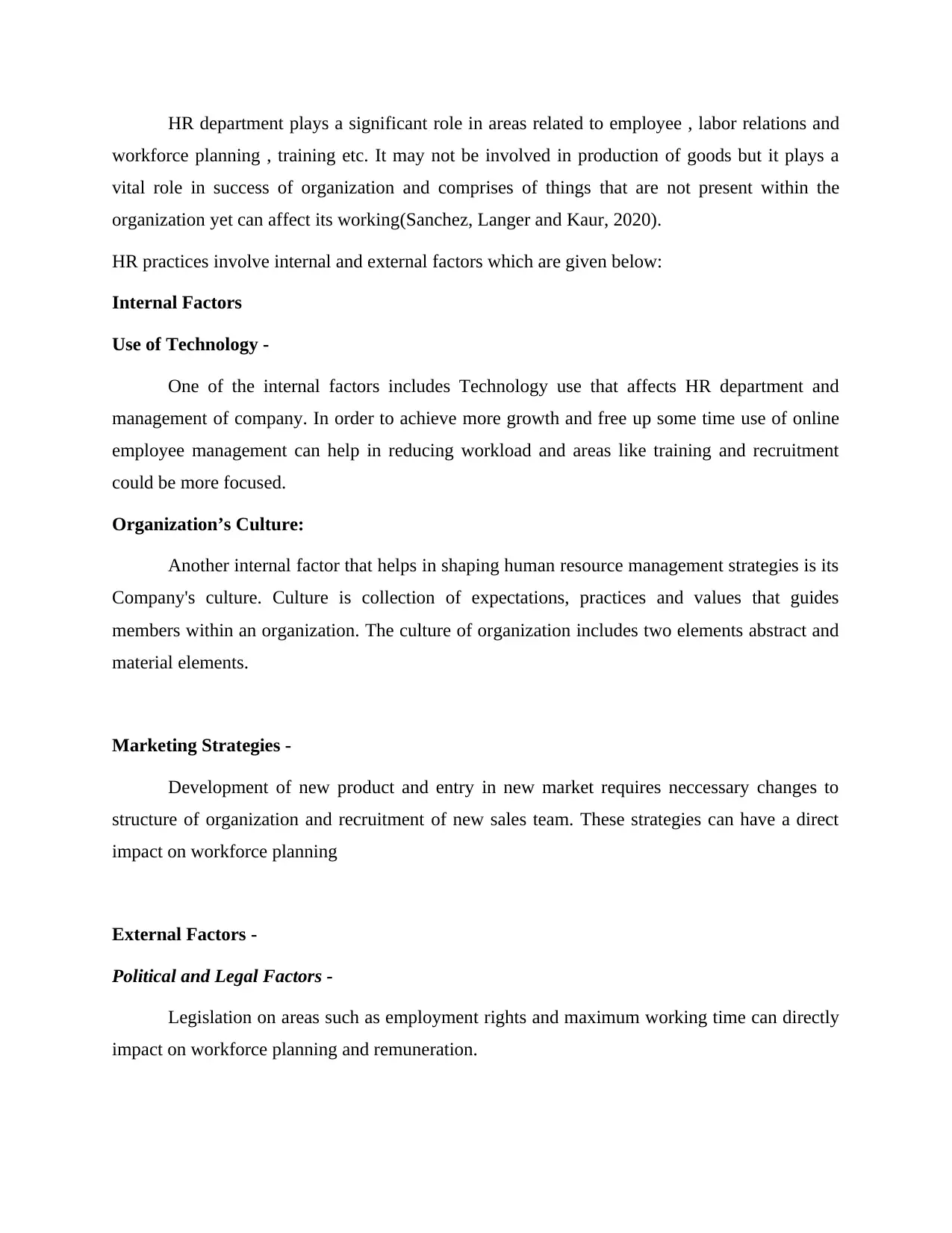
HR department plays a significant role in areas related to employee , labor relations and
workforce planning , training etc. It may not be involved in production of goods but it plays a
vital role in success of organization and comprises of things that are not present within the
organization yet can affect its working(Sanchez, Langer and Kaur, 2020).
HR practices involve internal and external factors which are given below:
Internal Factors
Use of Technology -
One of the internal factors includes Technology use that affects HR department and
management of company. In order to achieve more growth and free up some time use of online
employee management can help in reducing workload and areas like training and recruitment
could be more focused.
Organization’s Culture:
Another internal factor that helps in shaping human resource management strategies is its
Company's culture. Culture is collection of expectations, practices and values that guides
members within an organization. The culture of organization includes two elements abstract and
material elements.
Marketing Strategies -
Development of new product and entry in new market requires neccessary changes to
structure of organization and recruitment of new sales team. These strategies can have a direct
impact on workforce planning
External Factors -
Political and Legal Factors -
Legislation on areas such as employment rights and maximum working time can directly
impact on workforce planning and remuneration.
workforce planning , training etc. It may not be involved in production of goods but it plays a
vital role in success of organization and comprises of things that are not present within the
organization yet can affect its working(Sanchez, Langer and Kaur, 2020).
HR practices involve internal and external factors which are given below:
Internal Factors
Use of Technology -
One of the internal factors includes Technology use that affects HR department and
management of company. In order to achieve more growth and free up some time use of online
employee management can help in reducing workload and areas like training and recruitment
could be more focused.
Organization’s Culture:
Another internal factor that helps in shaping human resource management strategies is its
Company's culture. Culture is collection of expectations, practices and values that guides
members within an organization. The culture of organization includes two elements abstract and
material elements.
Marketing Strategies -
Development of new product and entry in new market requires neccessary changes to
structure of organization and recruitment of new sales team. These strategies can have a direct
impact on workforce planning
External Factors -
Political and Legal Factors -
Legislation on areas such as employment rights and maximum working time can directly
impact on workforce planning and remuneration.
Paraphrase This Document
Need a fresh take? Get an instant paraphrase of this document with our AI Paraphraser
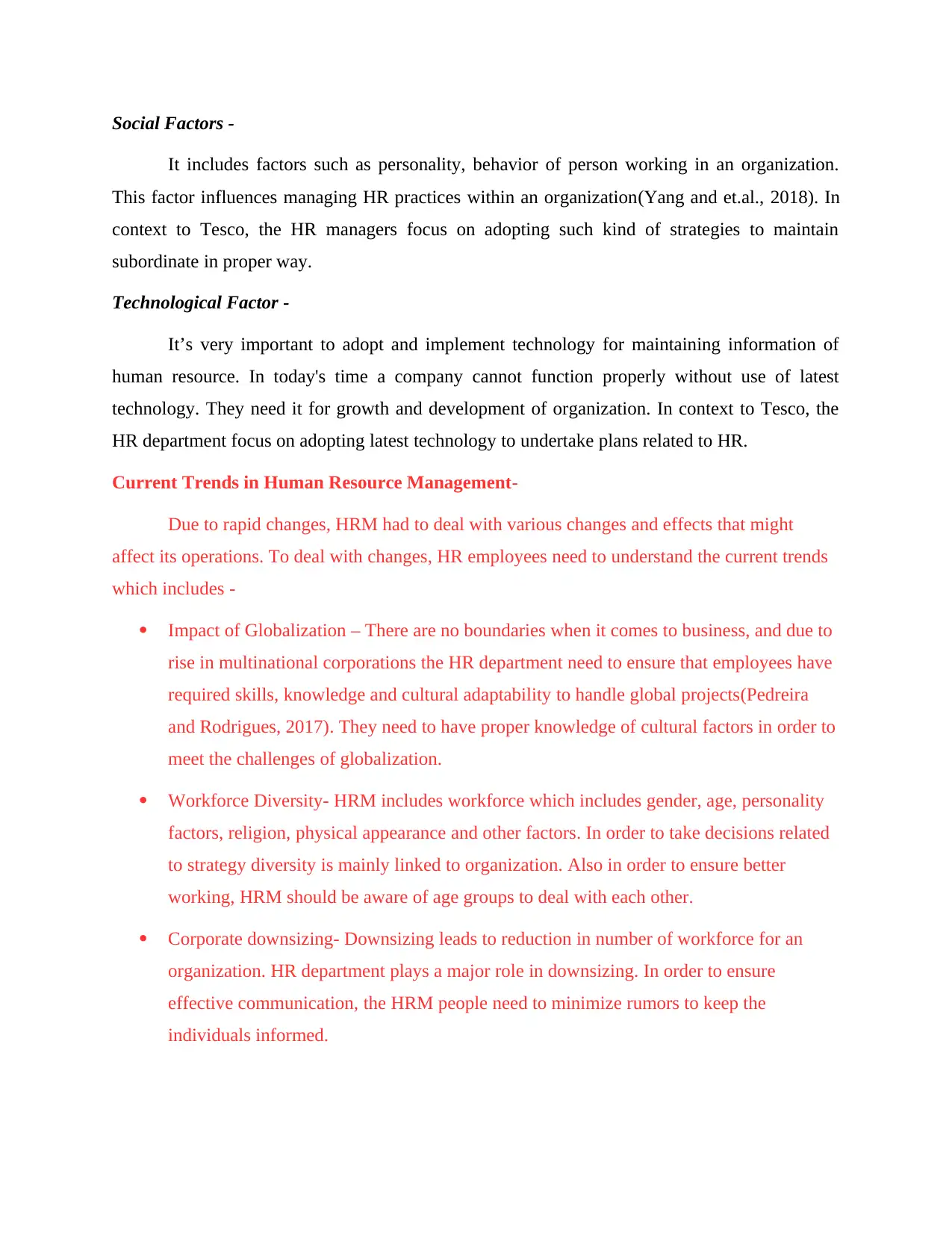
Social Factors -
It includes factors such as personality, behavior of person working in an organization.
This factor influences managing HR practices within an organization(Yang and et.al., 2018). In
context to Tesco, the HR managers focus on adopting such kind of strategies to maintain
subordinate in proper way.
Technological Factor -
It’s very important to adopt and implement technology for maintaining information of
human resource. In today's time a company cannot function properly without use of latest
technology. They need it for growth and development of organization. In context to Tesco, the
HR department focus on adopting latest technology to undertake plans related to HR.
Current Trends in Human Resource Management-
Due to rapid changes, HRM had to deal with various changes and effects that might
affect its operations. To deal with changes, HR employees need to understand the current trends
which includes -
Impact of Globalization – There are no boundaries when it comes to business, and due to
rise in multinational corporations the HR department need to ensure that employees have
required skills, knowledge and cultural adaptability to handle global projects(Pedreira
and Rodrigues, 2017). They need to have proper knowledge of cultural factors in order to
meet the challenges of globalization.
Workforce Diversity- HRM includes workforce which includes gender, age, personality
factors, religion, physical appearance and other factors. In order to take decisions related
to strategy diversity is mainly linked to organization. Also in order to ensure better
working, HRM should be aware of age groups to deal with each other.
Corporate downsizing- Downsizing leads to reduction in number of workforce for an
organization. HR department plays a major role in downsizing. In order to ensure
effective communication, the HRM people need to minimize rumors to keep the
individuals informed.
It includes factors such as personality, behavior of person working in an organization.
This factor influences managing HR practices within an organization(Yang and et.al., 2018). In
context to Tesco, the HR managers focus on adopting such kind of strategies to maintain
subordinate in proper way.
Technological Factor -
It’s very important to adopt and implement technology for maintaining information of
human resource. In today's time a company cannot function properly without use of latest
technology. They need it for growth and development of organization. In context to Tesco, the
HR department focus on adopting latest technology to undertake plans related to HR.
Current Trends in Human Resource Management-
Due to rapid changes, HRM had to deal with various changes and effects that might
affect its operations. To deal with changes, HR employees need to understand the current trends
which includes -
Impact of Globalization – There are no boundaries when it comes to business, and due to
rise in multinational corporations the HR department need to ensure that employees have
required skills, knowledge and cultural adaptability to handle global projects(Pedreira
and Rodrigues, 2017). They need to have proper knowledge of cultural factors in order to
meet the challenges of globalization.
Workforce Diversity- HRM includes workforce which includes gender, age, personality
factors, religion, physical appearance and other factors. In order to take decisions related
to strategy diversity is mainly linked to organization. Also in order to ensure better
working, HRM should be aware of age groups to deal with each other.
Corporate downsizing- Downsizing leads to reduction in number of workforce for an
organization. HR department plays a major role in downsizing. In order to ensure
effective communication, the HRM people need to minimize rumors to keep the
individuals informed.
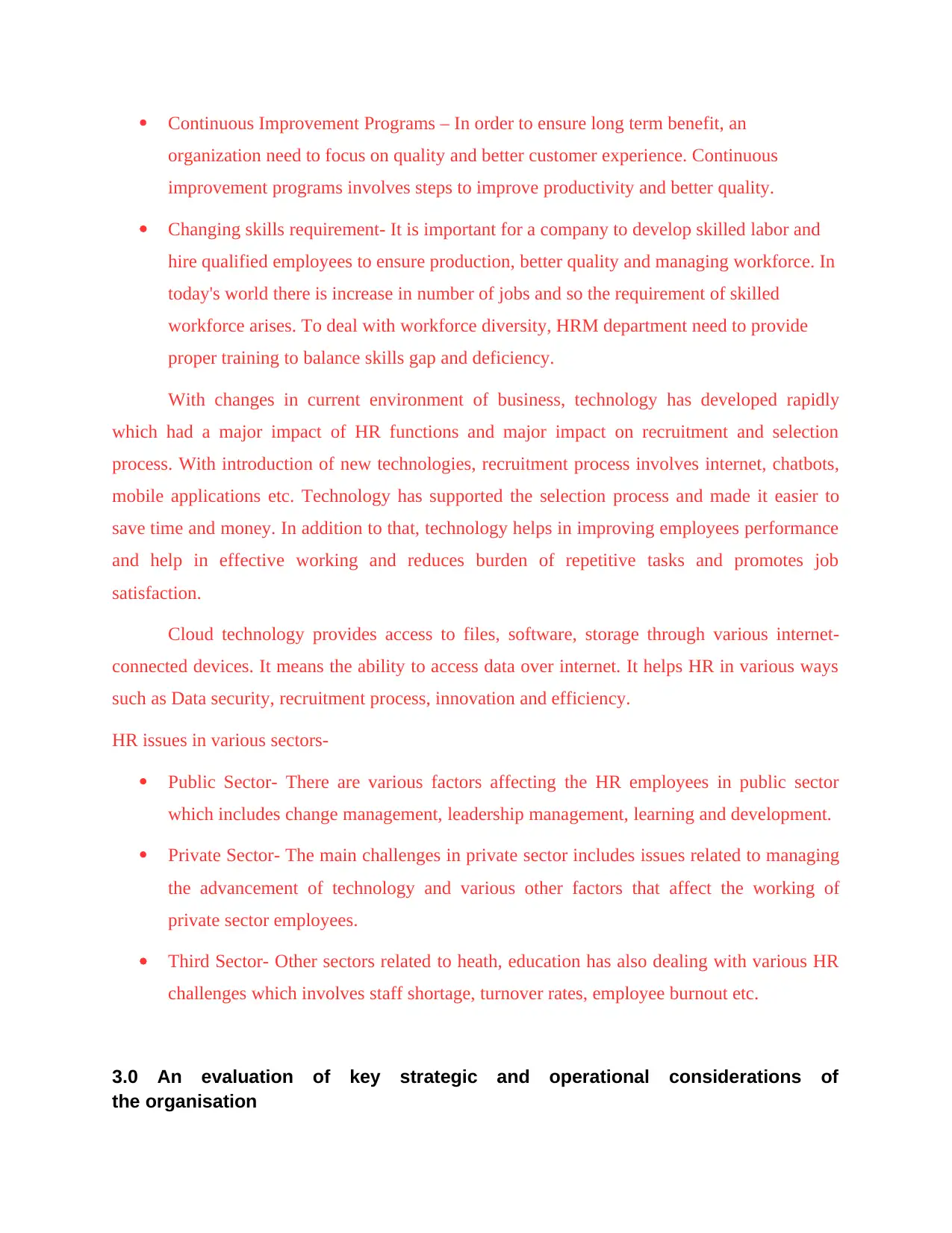
Continuous Improvement Programs – In order to ensure long term benefit, an
organization need to focus on quality and better customer experience. Continuous
improvement programs involves steps to improve productivity and better quality.
Changing skills requirement- It is important for a company to develop skilled labor and
hire qualified employees to ensure production, better quality and managing workforce. In
today's world there is increase in number of jobs and so the requirement of skilled
workforce arises. To deal with workforce diversity, HRM department need to provide
proper training to balance skills gap and deficiency.
With changes in current environment of business, technology has developed rapidly
which had a major impact of HR functions and major impact on recruitment and selection
process. With introduction of new technologies, recruitment process involves internet, chatbots,
mobile applications etc. Technology has supported the selection process and made it easier to
save time and money. In addition to that, technology helps in improving employees performance
and help in effective working and reduces burden of repetitive tasks and promotes job
satisfaction.
Cloud technology provides access to files, software, storage through various internet-
connected devices. It means the ability to access data over internet. It helps HR in various ways
such as Data security, recruitment process, innovation and efficiency.
HR issues in various sectors-
Public Sector- There are various factors affecting the HR employees in public sector
which includes change management, leadership management, learning and development.
Private Sector- The main challenges in private sector includes issues related to managing
the advancement of technology and various other factors that affect the working of
private sector employees.
Third Sector- Other sectors related to heath, education has also dealing with various HR
challenges which involves staff shortage, turnover rates, employee burnout etc.
3.0 An evaluation of key strategic and operational considerations of
the organisation
organization need to focus on quality and better customer experience. Continuous
improvement programs involves steps to improve productivity and better quality.
Changing skills requirement- It is important for a company to develop skilled labor and
hire qualified employees to ensure production, better quality and managing workforce. In
today's world there is increase in number of jobs and so the requirement of skilled
workforce arises. To deal with workforce diversity, HRM department need to provide
proper training to balance skills gap and deficiency.
With changes in current environment of business, technology has developed rapidly
which had a major impact of HR functions and major impact on recruitment and selection
process. With introduction of new technologies, recruitment process involves internet, chatbots,
mobile applications etc. Technology has supported the selection process and made it easier to
save time and money. In addition to that, technology helps in improving employees performance
and help in effective working and reduces burden of repetitive tasks and promotes job
satisfaction.
Cloud technology provides access to files, software, storage through various internet-
connected devices. It means the ability to access data over internet. It helps HR in various ways
such as Data security, recruitment process, innovation and efficiency.
HR issues in various sectors-
Public Sector- There are various factors affecting the HR employees in public sector
which includes change management, leadership management, learning and development.
Private Sector- The main challenges in private sector includes issues related to managing
the advancement of technology and various other factors that affect the working of
private sector employees.
Third Sector- Other sectors related to heath, education has also dealing with various HR
challenges which involves staff shortage, turnover rates, employee burnout etc.
3.0 An evaluation of key strategic and operational considerations of
the organisation
⊘ This is a preview!⊘
Do you want full access?
Subscribe today to unlock all pages.

Trusted by 1+ million students worldwide
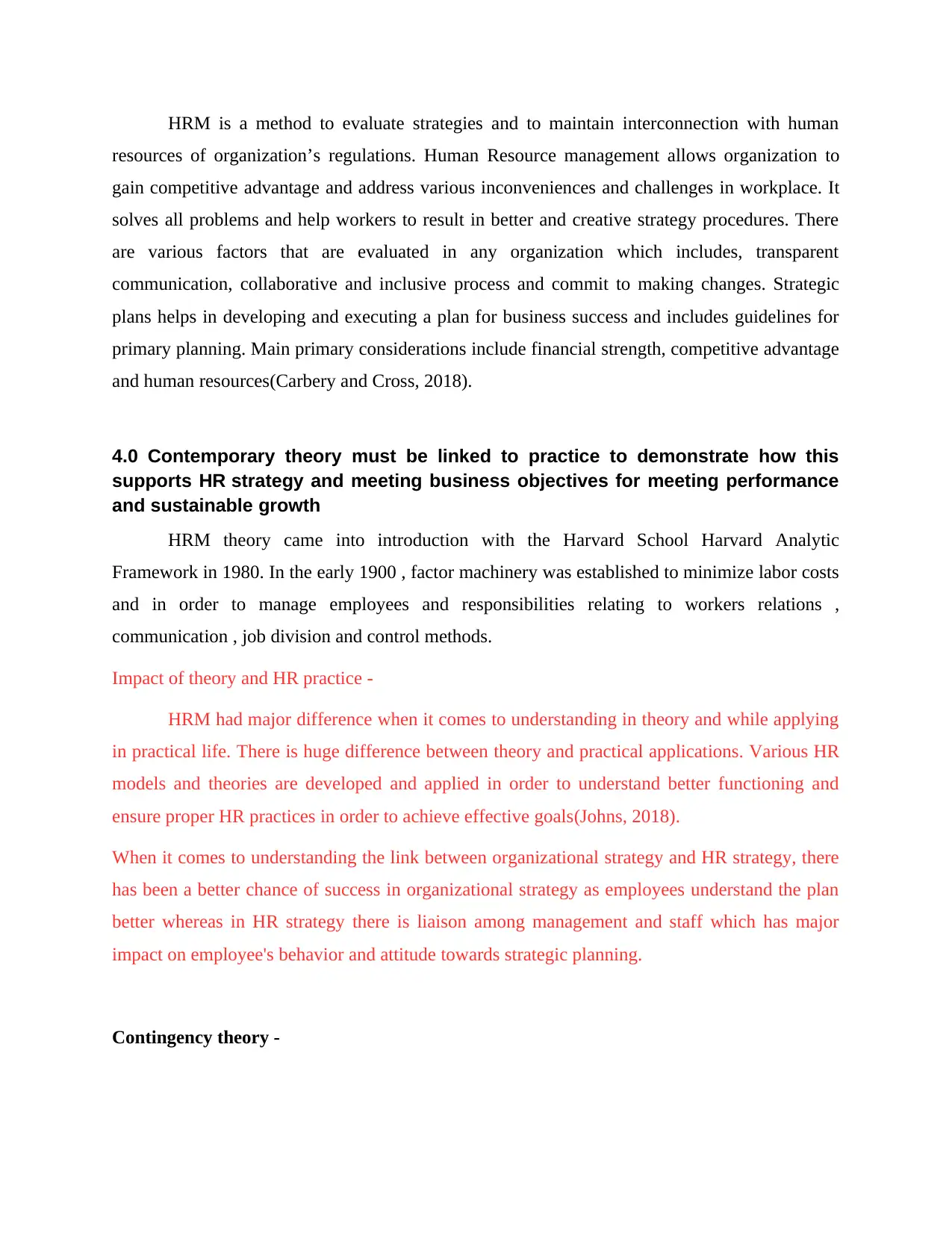
HRM is a method to evaluate strategies and to maintain interconnection with human
resources of organization’s regulations. Human Resource management allows organization to
gain competitive advantage and address various inconveniences and challenges in workplace. It
solves all problems and help workers to result in better and creative strategy procedures. There
are various factors that are evaluated in any organization which includes, transparent
communication, collaborative and inclusive process and commit to making changes. Strategic
plans helps in developing and executing a plan for business success and includes guidelines for
primary planning. Main primary considerations include financial strength, competitive advantage
and human resources(Carbery and Cross, 2018).
4.0 Contemporary theory must be linked to practice to demonstrate how this
supports HR strategy and meeting business objectives for meeting performance
and sustainable growth
HRM theory came into introduction with the Harvard School Harvard Analytic
Framework in 1980. In the early 1900 , factor machinery was established to minimize labor costs
and in order to manage employees and responsibilities relating to workers relations ,
communication , job division and control methods.
Impact of theory and HR practice -
HRM had major difference when it comes to understanding in theory and while applying
in practical life. There is huge difference between theory and practical applications. Various HR
models and theories are developed and applied in order to understand better functioning and
ensure proper HR practices in order to achieve effective goals(Johns, 2018).
When it comes to understanding the link between organizational strategy and HR strategy, there
has been a better chance of success in organizational strategy as employees understand the plan
better whereas in HR strategy there is liaison among management and staff which has major
impact on employee's behavior and attitude towards strategic planning.
Contingency theory -
resources of organization’s regulations. Human Resource management allows organization to
gain competitive advantage and address various inconveniences and challenges in workplace. It
solves all problems and help workers to result in better and creative strategy procedures. There
are various factors that are evaluated in any organization which includes, transparent
communication, collaborative and inclusive process and commit to making changes. Strategic
plans helps in developing and executing a plan for business success and includes guidelines for
primary planning. Main primary considerations include financial strength, competitive advantage
and human resources(Carbery and Cross, 2018).
4.0 Contemporary theory must be linked to practice to demonstrate how this
supports HR strategy and meeting business objectives for meeting performance
and sustainable growth
HRM theory came into introduction with the Harvard School Harvard Analytic
Framework in 1980. In the early 1900 , factor machinery was established to minimize labor costs
and in order to manage employees and responsibilities relating to workers relations ,
communication , job division and control methods.
Impact of theory and HR practice -
HRM had major difference when it comes to understanding in theory and while applying
in practical life. There is huge difference between theory and practical applications. Various HR
models and theories are developed and applied in order to understand better functioning and
ensure proper HR practices in order to achieve effective goals(Johns, 2018).
When it comes to understanding the link between organizational strategy and HR strategy, there
has been a better chance of success in organizational strategy as employees understand the plan
better whereas in HR strategy there is liaison among management and staff which has major
impact on employee's behavior and attitude towards strategic planning.
Contingency theory -
Paraphrase This Document
Need a fresh take? Get an instant paraphrase of this document with our AI Paraphraser
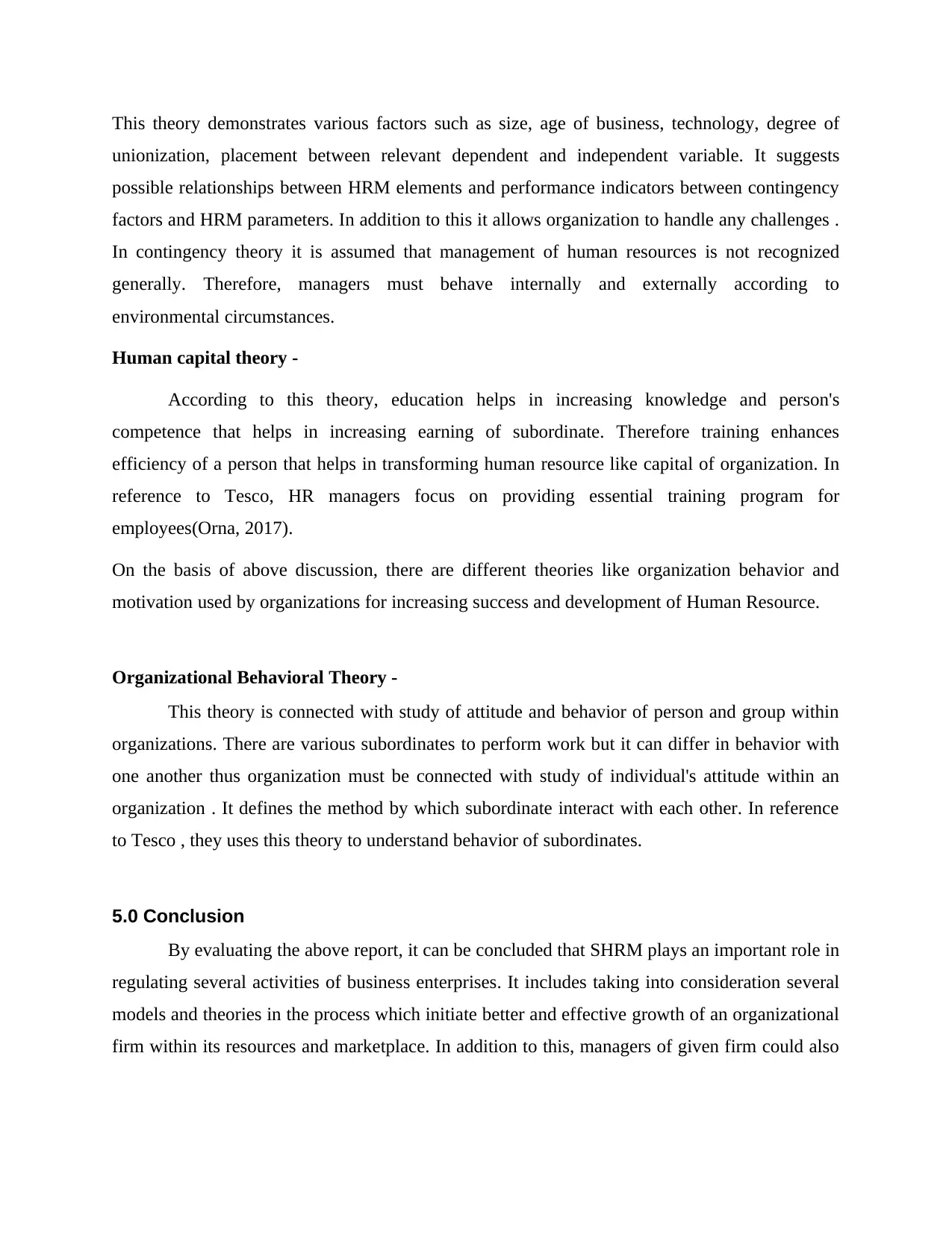
This theory demonstrates various factors such as size, age of business, technology, degree of
unionization, placement between relevant dependent and independent variable. It suggests
possible relationships between HRM elements and performance indicators between contingency
factors and HRM parameters. In addition to this it allows organization to handle any challenges .
In contingency theory it is assumed that management of human resources is not recognized
generally. Therefore, managers must behave internally and externally according to
environmental circumstances.
Human capital theory -
According to this theory, education helps in increasing knowledge and person's
competence that helps in increasing earning of subordinate. Therefore training enhances
efficiency of a person that helps in transforming human resource like capital of organization. In
reference to Tesco, HR managers focus on providing essential training program for
employees(Orna, 2017).
On the basis of above discussion, there are different theories like organization behavior and
motivation used by organizations for increasing success and development of Human Resource.
Organizational Behavioral Theory -
This theory is connected with study of attitude and behavior of person and group within
organizations. There are various subordinates to perform work but it can differ in behavior with
one another thus organization must be connected with study of individual's attitude within an
organization . It defines the method by which subordinate interact with each other. In reference
to Tesco , they uses this theory to understand behavior of subordinates.
5.0 Conclusion
By evaluating the above report, it can be concluded that SHRM plays an important role in
regulating several activities of business enterprises. It includes taking into consideration several
models and theories in the process which initiate better and effective growth of an organizational
firm within its resources and marketplace. In addition to this, managers of given firm could also
unionization, placement between relevant dependent and independent variable. It suggests
possible relationships between HRM elements and performance indicators between contingency
factors and HRM parameters. In addition to this it allows organization to handle any challenges .
In contingency theory it is assumed that management of human resources is not recognized
generally. Therefore, managers must behave internally and externally according to
environmental circumstances.
Human capital theory -
According to this theory, education helps in increasing knowledge and person's
competence that helps in increasing earning of subordinate. Therefore training enhances
efficiency of a person that helps in transforming human resource like capital of organization. In
reference to Tesco, HR managers focus on providing essential training program for
employees(Orna, 2017).
On the basis of above discussion, there are different theories like organization behavior and
motivation used by organizations for increasing success and development of Human Resource.
Organizational Behavioral Theory -
This theory is connected with study of attitude and behavior of person and group within
organizations. There are various subordinates to perform work but it can differ in behavior with
one another thus organization must be connected with study of individual's attitude within an
organization . It defines the method by which subordinate interact with each other. In reference
to Tesco , they uses this theory to understand behavior of subordinates.
5.0 Conclusion
By evaluating the above report, it can be concluded that SHRM plays an important role in
regulating several activities of business enterprises. It includes taking into consideration several
models and theories in the process which initiate better and effective growth of an organizational
firm within its resources and marketplace. In addition to this, managers of given firm could also
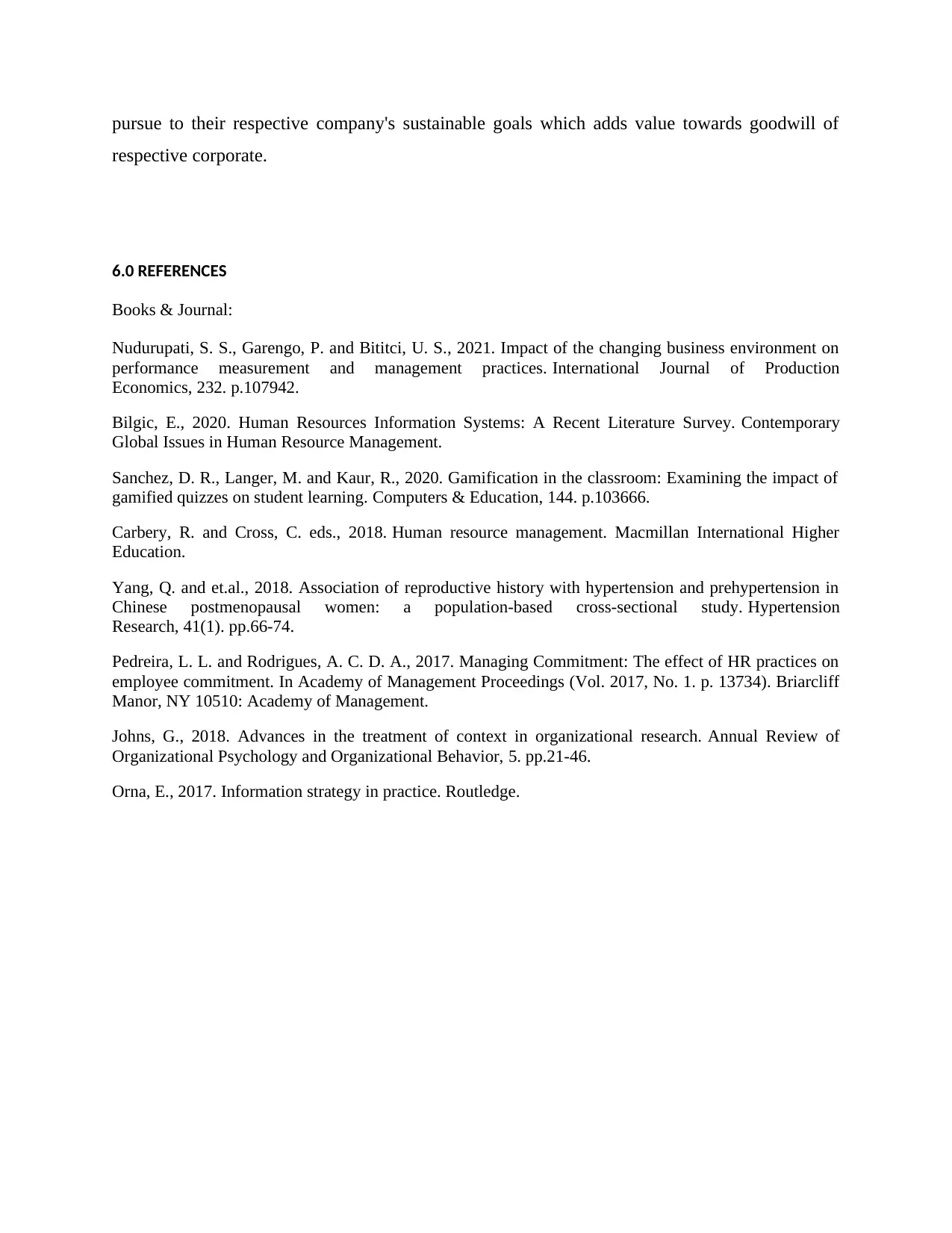
pursue to their respective company's sustainable goals which adds value towards goodwill of
respective corporate.
6.0 REFERENCES
Books & Journal:
Nudurupati, S. S., Garengo, P. and Bititci, U. S., 2021. Impact of the changing business environment on
performance measurement and management practices. International Journal of Production
Economics, 232. p.107942.
Bilgic, E., 2020. Human Resources Information Systems: A Recent Literature Survey. Contemporary
Global Issues in Human Resource Management.
Sanchez, D. R., Langer, M. and Kaur, R., 2020. Gamification in the classroom: Examining the impact of
gamified quizzes on student learning. Computers & Education, 144. p.103666.
Carbery, R. and Cross, C. eds., 2018. Human resource management. Macmillan International Higher
Education.
Yang, Q. and et.al., 2018. Association of reproductive history with hypertension and prehypertension in
Chinese postmenopausal women: a population-based cross-sectional study. Hypertension
Research, 41(1). pp.66-74.
Pedreira, L. L. and Rodrigues, A. C. D. A., 2017. Managing Commitment: The effect of HR practices on
employee commitment. In Academy of Management Proceedings (Vol. 2017, No. 1. p. 13734). Briarcliff
Manor, NY 10510: Academy of Management.
Johns, G., 2018. Advances in the treatment of context in organizational research. Annual Review of
Organizational Psychology and Organizational Behavior, 5. pp.21-46.
Orna, E., 2017. Information strategy in practice. Routledge.
respective corporate.
6.0 REFERENCES
Books & Journal:
Nudurupati, S. S., Garengo, P. and Bititci, U. S., 2021. Impact of the changing business environment on
performance measurement and management practices. International Journal of Production
Economics, 232. p.107942.
Bilgic, E., 2020. Human Resources Information Systems: A Recent Literature Survey. Contemporary
Global Issues in Human Resource Management.
Sanchez, D. R., Langer, M. and Kaur, R., 2020. Gamification in the classroom: Examining the impact of
gamified quizzes on student learning. Computers & Education, 144. p.103666.
Carbery, R. and Cross, C. eds., 2018. Human resource management. Macmillan International Higher
Education.
Yang, Q. and et.al., 2018. Association of reproductive history with hypertension and prehypertension in
Chinese postmenopausal women: a population-based cross-sectional study. Hypertension
Research, 41(1). pp.66-74.
Pedreira, L. L. and Rodrigues, A. C. D. A., 2017. Managing Commitment: The effect of HR practices on
employee commitment. In Academy of Management Proceedings (Vol. 2017, No. 1. p. 13734). Briarcliff
Manor, NY 10510: Academy of Management.
Johns, G., 2018. Advances in the treatment of context in organizational research. Annual Review of
Organizational Psychology and Organizational Behavior, 5. pp.21-46.
Orna, E., 2017. Information strategy in practice. Routledge.
⊘ This is a preview!⊘
Do you want full access?
Subscribe today to unlock all pages.

Trusted by 1+ million students worldwide
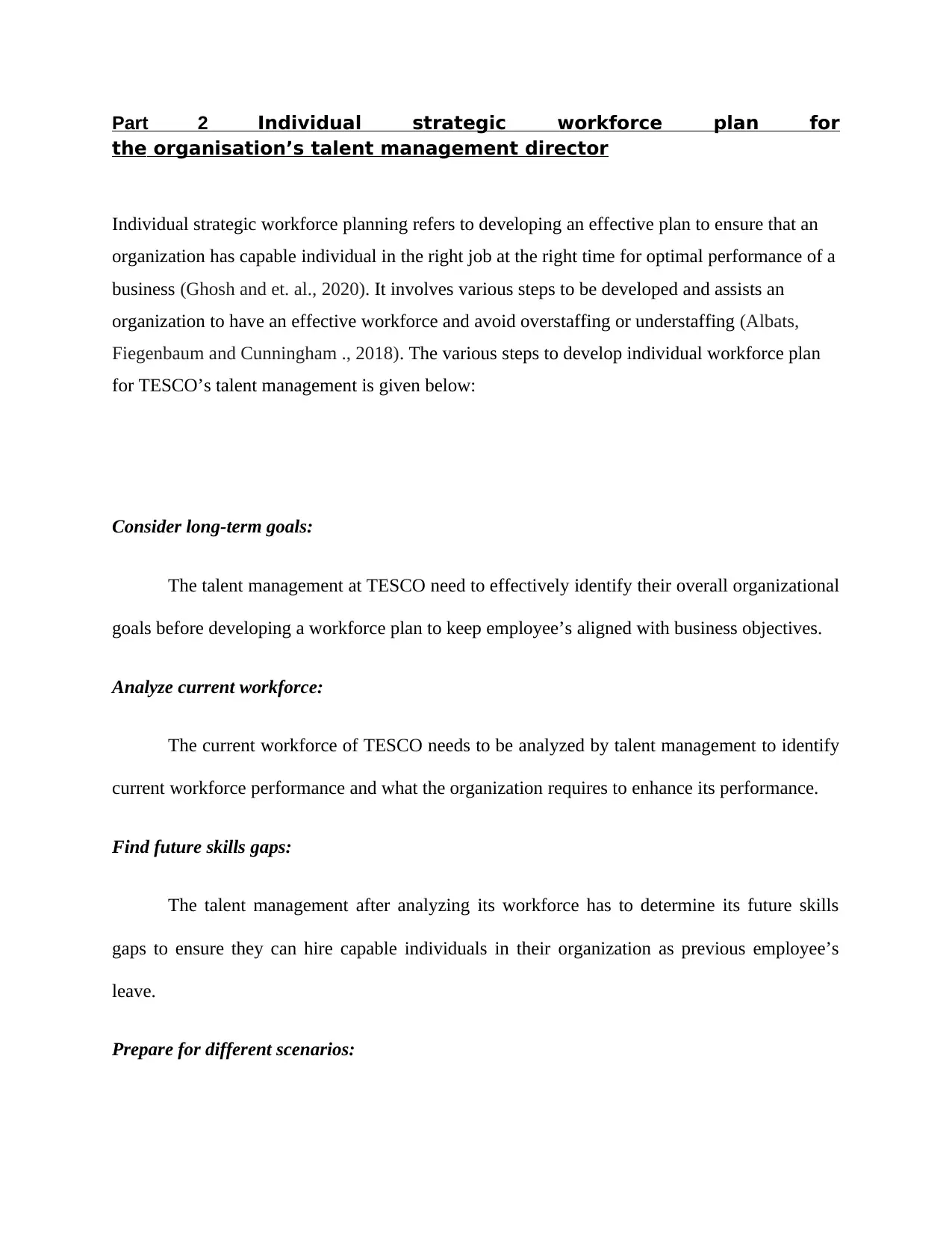
Part 2 Individual strategic workforce plan for
the organisation’s talent management director
Individual strategic workforce planning refers to developing an effective plan to ensure that an
organization has capable individual in the right job at the right time for optimal performance of a
business (Ghosh and et. al., 2020). It involves various steps to be developed and assists an
organization to have an effective workforce and avoid overstaffing or understaffing (Albats,
Fiegenbaum and Cunningham ., 2018). The various steps to develop individual workforce plan
for TESCO’s talent management is given below:
Consider long-term goals:
The talent management at TESCO need to effectively identify their overall organizational
goals before developing a workforce plan to keep employee’s aligned with business objectives.
Analyze current workforce:
The current workforce of TESCO needs to be analyzed by talent management to identify
current workforce performance and what the organization requires to enhance its performance.
Find future skills gaps:
The talent management after analyzing its workforce has to determine its future skills
gaps to ensure they can hire capable individuals in their organization as previous employee’s
leave.
Prepare for different scenarios:
the organisation’s talent management director
Individual strategic workforce planning refers to developing an effective plan to ensure that an
organization has capable individual in the right job at the right time for optimal performance of a
business (Ghosh and et. al., 2020). It involves various steps to be developed and assists an
organization to have an effective workforce and avoid overstaffing or understaffing (Albats,
Fiegenbaum and Cunningham ., 2018). The various steps to develop individual workforce plan
for TESCO’s talent management is given below:
Consider long-term goals:
The talent management at TESCO need to effectively identify their overall organizational
goals before developing a workforce plan to keep employee’s aligned with business objectives.
Analyze current workforce:
The current workforce of TESCO needs to be analyzed by talent management to identify
current workforce performance and what the organization requires to enhance its performance.
Find future skills gaps:
The talent management after analyzing its workforce has to determine its future skills
gaps to ensure they can hire capable individuals in their organization as previous employee’s
leave.
Prepare for different scenarios:
Paraphrase This Document
Need a fresh take? Get an instant paraphrase of this document with our AI Paraphraser
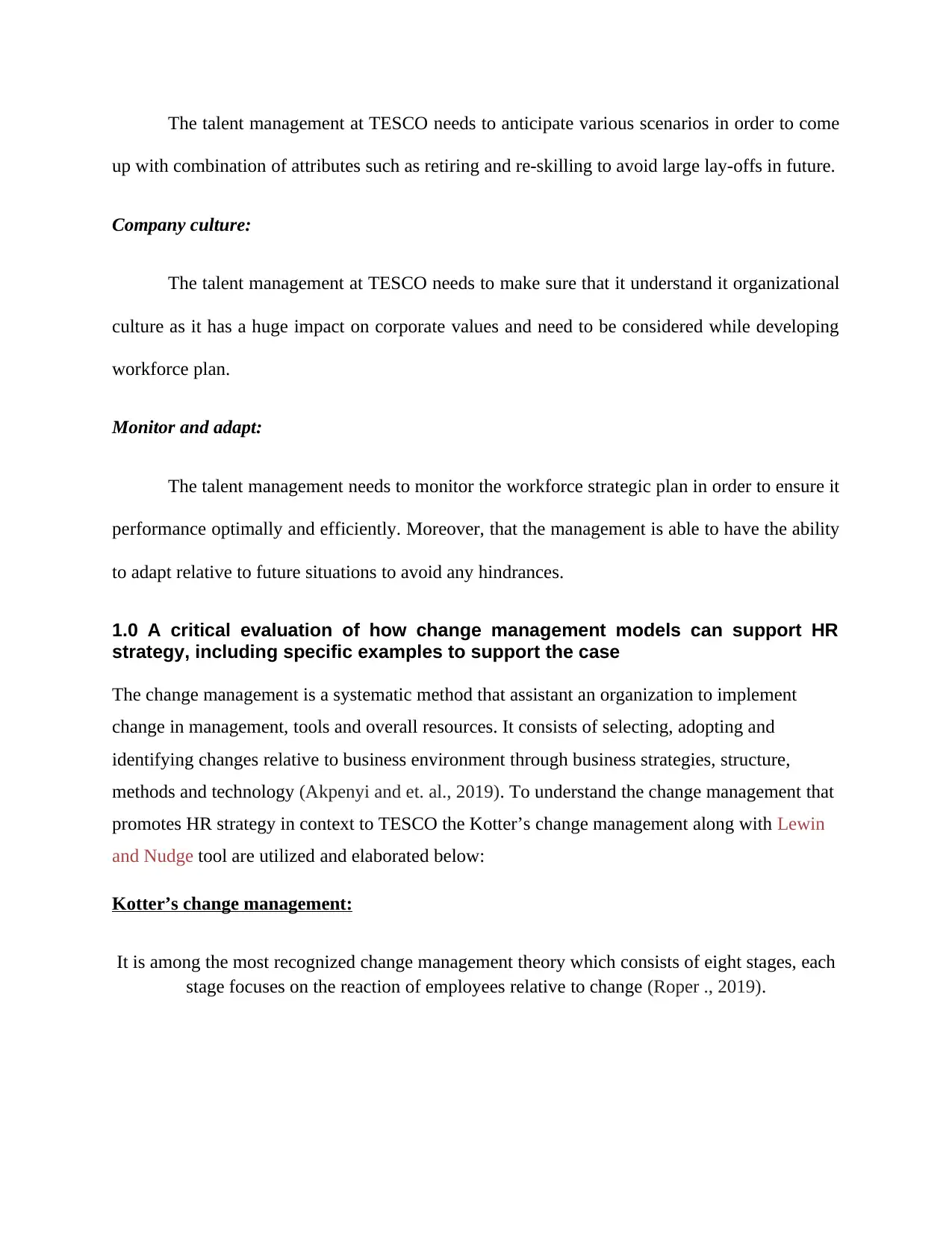
The talent management at TESCO needs to anticipate various scenarios in order to come
up with combination of attributes such as retiring and re-skilling to avoid large lay-offs in future.
Company culture:
The talent management at TESCO needs to make sure that it understand it organizational
culture as it has a huge impact on corporate values and need to be considered while developing
workforce plan.
Monitor and adapt:
The talent management needs to monitor the workforce strategic plan in order to ensure it
performance optimally and efficiently. Moreover, that the management is able to have the ability
to adapt relative to future situations to avoid any hindrances.
1.0 A critical evaluation of how change management models can support HR
strategy, including specific examples to support the case
The change management is a systematic method that assistant an organization to implement
change in management, tools and overall resources. It consists of selecting, adopting and
identifying changes relative to business environment through business strategies, structure,
methods and technology (Akpenyi and et. al., 2019). To understand the change management that
promotes HR strategy in context to TESCO the Kotter’s change management along with Lewin
and Nudge tool are utilized and elaborated below:
Kotter’s change management:
It is among the most recognized change management theory which consists of eight stages, each
stage focuses on the reaction of employees relative to change (Roper ., 2019).
up with combination of attributes such as retiring and re-skilling to avoid large lay-offs in future.
Company culture:
The talent management at TESCO needs to make sure that it understand it organizational
culture as it has a huge impact on corporate values and need to be considered while developing
workforce plan.
Monitor and adapt:
The talent management needs to monitor the workforce strategic plan in order to ensure it
performance optimally and efficiently. Moreover, that the management is able to have the ability
to adapt relative to future situations to avoid any hindrances.
1.0 A critical evaluation of how change management models can support HR
strategy, including specific examples to support the case
The change management is a systematic method that assistant an organization to implement
change in management, tools and overall resources. It consists of selecting, adopting and
identifying changes relative to business environment through business strategies, structure,
methods and technology (Akpenyi and et. al., 2019). To understand the change management that
promotes HR strategy in context to TESCO the Kotter’s change management along with Lewin
and Nudge tool are utilized and elaborated below:
Kotter’s change management:
It is among the most recognized change management theory which consists of eight stages, each
stage focuses on the reaction of employees relative to change (Roper ., 2019).
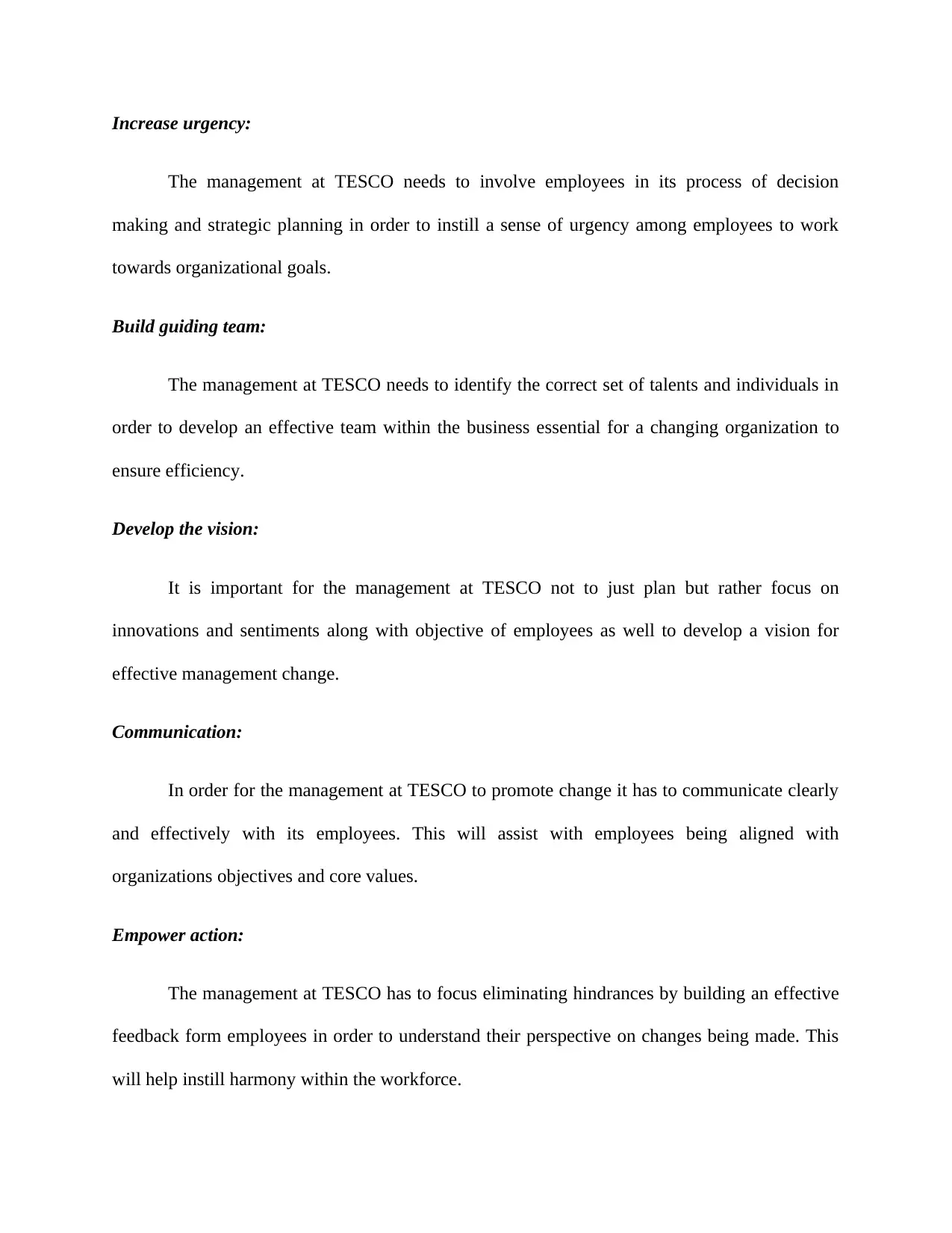
Increase urgency:
The management at TESCO needs to involve employees in its process of decision
making and strategic planning in order to instill a sense of urgency among employees to work
towards organizational goals.
Build guiding team:
The management at TESCO needs to identify the correct set of talents and individuals in
order to develop an effective team within the business essential for a changing organization to
ensure efficiency.
Develop the vision:
It is important for the management at TESCO not to just plan but rather focus on
innovations and sentiments along with objective of employees as well to develop a vision for
effective management change.
Communication:
In order for the management at TESCO to promote change it has to communicate clearly
and effectively with its employees. This will assist with employees being aligned with
organizations objectives and core values.
Empower action:
The management at TESCO has to focus eliminating hindrances by building an effective
feedback form employees in order to understand their perspective on changes being made. This
will help instill harmony within the workforce.
The management at TESCO needs to involve employees in its process of decision
making and strategic planning in order to instill a sense of urgency among employees to work
towards organizational goals.
Build guiding team:
The management at TESCO needs to identify the correct set of talents and individuals in
order to develop an effective team within the business essential for a changing organization to
ensure efficiency.
Develop the vision:
It is important for the management at TESCO not to just plan but rather focus on
innovations and sentiments along with objective of employees as well to develop a vision for
effective management change.
Communication:
In order for the management at TESCO to promote change it has to communicate clearly
and effectively with its employees. This will assist with employees being aligned with
organizations objectives and core values.
Empower action:
The management at TESCO has to focus eliminating hindrances by building an effective
feedback form employees in order to understand their perspective on changes being made. This
will help instill harmony within the workforce.
⊘ This is a preview!⊘
Do you want full access?
Subscribe today to unlock all pages.

Trusted by 1+ million students worldwide
1 out of 36
Related Documents
Your All-in-One AI-Powered Toolkit for Academic Success.
+13062052269
info@desklib.com
Available 24*7 on WhatsApp / Email
![[object Object]](/_next/static/media/star-bottom.7253800d.svg)
Unlock your academic potential
Copyright © 2020–2025 A2Z Services. All Rights Reserved. Developed and managed by ZUCOL.



